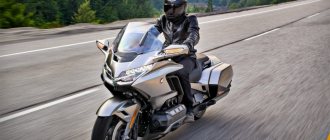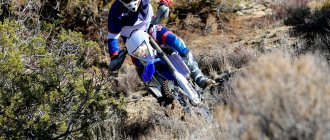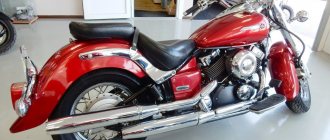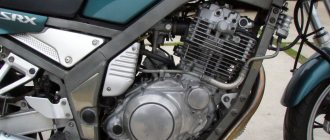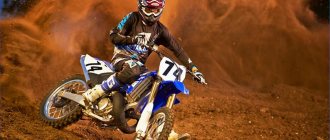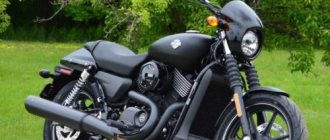, presented to the public in 1987, became a real find. This model turned out to be so successful that its production continued for 30 years , and according to the developers, “we are not going to remove it from the assembly line.” Initial plans included only the US and Japanese markets , but consumer interest from European countries forced the Japanese to reconsider their decision.
This Yamaha was delivered to Spain, from where it spread to other countries of the continent.
Yamaha TW 200 design
A motorcycle for Enduro and a cruiser rolled into one.
There are no special details in the motorcycle that aroused such consumer interest. The reason is hidden in the general concept . The model is not intended for track racing, but it can be used for light walks on difficult off-road terrain, as well as long trips.
In other words, dual sport - enduro + cruiser.
Side view.
Off-road conqueror.
On a white background.
The frame is made of steel, traditionally for models of this level, high-precision casting, which allows welding points to be reduced to a minimum. This principle made it possible to lighten the model while maintaining rigidity. Other features include good driving performance and minimal gas consumption, comparable to a scooter.
Suspension
At the front there is a fork, at the rear there is a monoshock absorber on the pendulum.
- The front suspension is made on the basis of a telescopic fork, the working stroke of which is 150 mm .
- At the rear there is a standard for the brand, a monoshock absorber on the pendulum. Its reserve is 160 mm .
There are no adjustment options, which allowed us to save a little on the final cost.
Generations
The model performed very well, so there were no deep changes.
The model turned out to be so successful that during the entire assembly it underwent only one minor change.
In the starting system, the starter leg was replaced with a conventional push-button version. Nevertheless, according to the factory documentation, the version with the button is the second generation, and the one with the leg is the first.
Exterior
Despite the fact that the model is not a racing model, the first glance at it evokes just such associations. External body kit is reduced to the required minimum.
Minimum body kit, asceticism and strict lines.
Ascetic, strict, but at the same time very elegant. It’s interesting that if you look closely, you’ll notice that the bottom of the engine is covered with a protective plate. True, in pursuit of lightness and ventilation, the developers have provided so many holes in it that the possibility of protection remains a big question .
Front end
Despite the SUV class, the front wing, as conceived by the developers, should move with the tire, maximally protecting the pilot from dirt.
The model became the basis for many custom developments.
The main working part for shock absorption is located above it. There is no body kit as such at the front ; there is empty space between the tire and the head optics unit.
- A large square headlight (the first versions with a round headlight) with a minimal amount of plastic around is responsible for illuminating the road There is no separate division into low/high beam.
- The turn signals are mounted to the sides on separate legs.
- The front is colored glass , the back is opaque black plastic.
- An interesting design idea was the installation of reflectors (reflectors) on the sides of the block . They are located in its lower part, directed in different directions.
- A windshield is not provided in principle, but in many cases it is not necessary.
- The gas tank, with a capacity of 7 liters , fits so organically into the outline of the frame that it is practically invisible. The main protruding part is the neck cover.
Dashboard
When developing this part, the engineers followed the path typical for enduro versions.
Minimum options.
Analog speedometer, tachometer, and other control indicators - light bulbs that cluster on the left side. It is installed quite compactly, you can catch all the indicators at one glance.
All buttons and switches are located in a standard way, falling right under your fingers. The steering wheel is high and horned , but it is comfortable to drive even for a person who is not very tall. The mirrors are round and have limited adjustment options, but are initially positioned above the steering grips, making it possible to read the road situation without any problems.
Rear end
There is no rear wing; its role is played by the lower part of the frame.
- The mudguard is short , and above it, slightly protruding, are the stop and parking signals. The turn indicators are made in the same style as the front ones.
- Just like the front, three reflectors - two on the sides, one below.
- The saddle does not have a step , it is made in one block, repeating the bend of the frame. The possibility of seating a rear passenger is provided, but there may not be enough space for him.
- The design of the motorcycle allows for a choice - either traveling together or installing a rear case . The space for it is minimal. Given that the seat rack is small (the design of the saddle), going on long journeys on a motorcycle can be difficult.
Power point
A simple and economical engine, what else do you need for Enduro when you are far from civilization. A symbol of reliability!
One of the features that ensured great demand for the model was its simple, but at the same time very economical engine . Its characteristics turned out to be so successful that the initially planned replacement of the fuel supply system remained only in the drawings.
It was a 1-cylinder, 4-stroke engine that produced:
- working volume - 197 cm3;
- power - 15 hp;
- number of valves - 2;
- cooling - air;
- fuel supply - carburetor;
- ignition - electronic transistor;
- start - kick starter leg (until 2000), electric starter (since 2001);
- Tank volume - 7 l (6 + 1 reserve).
Since 2001, they began to install a different carburetor, but this did not change the main characteristics, fuel consumption decreased slightly.
Unlike other versions of the brand, here the engineers decided to use third-party development. Carburetors were supplied by the Japanese company Teikei .
Transmission and clutch
The motorcycle was equipped with a 5-speed gearbox. The switching pattern was standard.
Many bikers note the clarity of gearbox shifts.
Users noted the extraordinary smoothness and clarity of switching . True, there were cases when, instead of neutral, some other, not necessarily second, gear was engaged. “He sometimes switches gears according to a pattern that defies ordinary human logic. Roulette with one cartridge."
- Drive by chain.
- The clutch, according to the design typical for all Yamaha models, is multi-disc, oil bath .
Brakes
One of the details that did not characterize the bike from the best side were the brakes. Until 2001, drum versions were installed on both axles .
Until 2001 there were only drums here. With them the motorcycle braked very mediocrely.
When the generation changed, the front received disc:
- number of disks – 1;
- diameter – 220 mm;
- support – 2-piston,
The rear ones remained unchanged.
Front disc brakes with a diameter of 220 mm.
Enduro motorcycle chassis
The lightweight half-duplex frame uses the engine as a load-bearing element. This reduces the weight of the enduro motorcycle by eliminating the part of the frame that supports the engine, and simplifies the design of the motorcycle. The steering column holds the fork at a 25.8-degree angle and the trail is 86 millimeters. To a knowledgeable person, these numbers will tell you that the Yamaha TW200 is a nimble and responsive device when steering.
The 33 mm fork has a stroke of 16 cm. It has corrugated covers that protect the moving open parts of the fork from dirt that destroys the seals. A motor shock absorber with an external spring suspends the rectangular pendulum, giving the rear wheel 15 cm of travel. Although the suspension travel cannot be compared with pure off-road bikes, the suspension is soft and quite adequate for a universal motorcycle.
The TW200's braking system consists of a 110mm cable-actuated drum brake at the rear wheel and a hydraulic caliper on a 220mm disc at the front. The disc size is quite sufficient, but it lacks a contoured edge to improve self-cleaning, so there is some work to be done here. The wheels are spoked, well suited for off-road driving, and thick all-purpose tires measuring 130/80-18 at the front and 180/80-14 at the rear, due to their softness, partly complement the suspension.
Yamaha tw 200 2019 engine
Driving performance
According to the developers, the main application for the model was supposed to be fast and not very fast trips over rough terrain with many medium-sized obstacles, so the specification does not have any special racing characteristics.
Maximum speed
- Maximum speed - 120 km/h .
According to users, you can squeeze out more. The power reserve is small, but squeezing it so that the arrow lies is enough.
Fuel consumption
Claimed fuel consumption is 3.0 . Before 2000 it was 3.5 .
When driving in a mixed cycle, focus on fuel consumption of 4 liters per hundred
In a mixed cycle, the figure can approach the 4 liter mark, but still remains a clear record among representatives of the class.
Acceleration to hundreds
- Acceleration, as for a tourist, is considered normal - up to 9 seconds .
Yamaha TW200 engine
Although the 196cc four-stroke air-cooled engine seems quite small, it is sufficient for the Yamaha TW200. The short-stroke engine has a compression ratio of 9.5:1, so does not require high-octane fuel, and the Mikuni carburetor with a 28mm choke is easy to set up and maintain. Capacitor ignition, on the other hand, requires no adjustments or maintenance and simply gets the job done, while the automatic timing chain tensioner means you can spend less time in the garage and more time on the bike. A five-speed constant mesh transmission transmits torque to the rear wheel via a chain drive. The lack of a kickstarter is somewhat discouraging, since the volume allows it, and the off-road enduro nature and simple design practically oblige it to have it.
Dimensions
Since the model was not positioned as a purely Japanese model, a person of both small and medium height can feel comfortable behind the wheel. The thoughtful placement of footrests and controls should not create problems for a tall motorcyclist.
Owners note a comfortable fit for a person of small and medium height.
At the same time, the lightness of the model and the large steering angle will allow you to maneuver normally in any situation.
Weight
Curb weight - 126 kg.
196 kg is a lot for Enduro..
The bikes supplied to the US markets were heavier . All American models received chrome trim to the maximum. But at the same time, the overall dimensions changed only once, with the change of generation.
The first data is before 2000, the second is after. The first and second generations, respectively.
- in length - 2091, 2061 mm;
- width - 822, 832 mm;
- height - 1121, 1106 mm;
- saddle height - 792 mm for both generations.
Wheelbase - 1251, 1322 mm .
Brief history of the model
1987 - start of production and sales. Model: Yamaha TW200; Yamaha TW200T (Trailway) (Japan; North America). Factory designation: 2JL0.
1988 - no significant changes. Model: Yamaha TW200U (Trailway) (North America).
1989 - start of production and sales in Europe. Model: Yamaha TW200W (Trailway); Yamaha TW200E (North America; Europe). Factory designation: 3LY1, 3AW4.
1990 - no significant changes. Model: Yamaha TW200A (Trailway); Yamaha TW200E (North America; Europe). Factory designation: 3AW7.
1991 - no significant changes. Model: Yamaha TW200; Yamaha TW200B (Trailway); Yamaha TW200E (Japan; North America; Europe). Factory designation: 4CS1; 3AWA.
1992 - no significant changes. Model: Yamaha TW200D (Trailway); Yamaha TW200E (North America; Europe). Factory designation: 4CS1; 3AWD.
1993 - no significant changes. Model: Yamaha TW200; Yamaha TW200E (Trailway) (Japan; North America). Factory designation: 4CS2.
1994 - no significant changes. Model: Yamaha TW200E (Europe). Factory designation: 3LY2, 3AWK.
1995 - no significant changes. Model: Yamaha TW200G (Trailway); Yamaha TW200E (North America; Europe). Factory designation: 3AWN.
1996 - no significant changes. Model: Yamaha TW200; Yamaha TW200H (Trailway); Yamaha TW200E (Japan; North America; Europe). Factory designation: 4CS3; 3AWS.
1997 - no significant changes. Model: Yamaha TW200J (Trailway); Yamaha TW200E (North America; Europe). Factory designation: 3AWV.
1998 - the scrambler version of the TW200E appears on the domestic Japanese market. Model: Yamaha TW200 + TW200E; Yamaha TW200K (Trailway); Yamaha TW200E (Japan; North America; Europe). Factory designation: 4CS5 + 4CS4; 3AWY.
1999 - The regular version of the TW200 is no longer offered in the Japanese market. Model: Yamaha TW200E; Yamaha TW200L (Trailway); Yamaha TW200E (Japan; North America; Europe). Factory designation: 4CS6; 5FY4.
2000 - the domestic Japanese scrambler version of the TW200E receives a front disc brake and minor changes associated with stricter environmental standards (the curb weight increased by 2 kg). Model: Yamaha TW200E; Yamaha TW200M (Trailway); Yamaha TW200E (Japan; North America; Europe). Factory designation: 5LB1; 5FY7.
2001 is the last year of production of the domestic Japanese TW200E. Export versions receive a front disc brake. The Trailway prefix in the name of the American versions was removed. Model: Yamaha TW200E; Yamaha TW200N; Yamaha TW200E (Japan; North America; Europe). Factory designation: 5LB2; 5FYA.
2002 - no significant changes. Model: Yamaha TW200P; Yamaha TW200E (North America; Europe). Factory designation: 5FYE.
2003 - no significant changes. Model: Yamaha TW200R; Yamaha TW200E (North America; Europe). Factory designation: 5FYJ.
2004 - no significant changes. Model: Yamaha TW200S; Yamaha TW200E (North America; Europe). Factory designation: 5FYN.
2005 - no significant changes. Model: Yamaha TW200T1; Yamaha TW200E (North America; Europe). Factory designation: 5FYT.
2006 - no significant changes. Model: Yamaha TW200V; Yamaha TW200E (North America; Europe). Factory designation: 5FYX.
2007 - no significant changes. Model: Yamaha TW200W1; Yamaha TW200E (North America; Europe). Factory designation: 10D3.
2008 - no significant changes. Model: Yamaha TW200X; Yamaha TW200E (North America; Europe). Factory designation: 10D7.
2009 - no significant changes. Model: Yamaha TW200Y; Yamaha TW200E (North America; Europe). Factory designation: 10D8.
2010 - no significant changes. Model: Yamaha TW200Z; Yamaha TW200E (North America; Europe). Factory designation: 10DF.
2011 - no significant changes. Model: Yamaha TW200A1; Yamaha TW200E (North America; Europe). Factory designation: 10DK.
2012 - no significant changes. Model: Yamaha TW200B1; Yamaha TW200E (North America; Europe). Factory designation: 10DP.
2013 is the last year of production of European versions. Model: Yamaha TW200D1; Yamaha TW200E (North America; Europe). Factory designation: 10DU.
2014 - no significant changes. Model: Yamaha TW200E1 (USA); Yamaha TW200E (Canada). Factory designation: 10DX.
2015 - no significant changes. Model: Yamaha TW200F1 (USA); Yamaha TW200E (Canada). Factory designation: B753.
2016 - no significant changes. Model: Yamaha TW200G1 (USA); Yamaha TW200E (Canada). Factory designation: B756.
2017 - no significant changes. Model: Yamaha TW200H1 (USA); Yamaha TW200E (Canada). Factory designation: B759.
2018 - no significant changes. Model: Yamaha TW200 (USA); Yamaha TW200E (Canada). Factory designation: B75C.
2019 - no significant changes. Model: Yamaha TW200 (USA); Yamaha TW200E (Canada).
2020 - no significant changes. Model: Yamaha TW200 (USA); Yamaha TW200E (Canada).
2021 - no significant changes. Model: Yamaha TW200 (USA); Yamaha TW200E (Canada).
Modifications
The generation change was the only official modification of the model.
Yamaha TW 225 is a rare guest in both foreign and domestic markets
In 2002, a limited number of bikes were produced on its basis, smaller in size, but with a more powerful engine. The modification did not receive an external name, but by analogy with the base model it was dubbed Yamaha TW 225 . The model did not appear in foreign markets; it was also difficult to find in domestic markets.
Yamaha TW200 2022 Design
Anti-injectors, rejoice! Off-road motorcycles still come with carburetors. In general, the characteristics of the Yamaha TW200 are still the same as 10 years ago, but this should not stop you.
The first thing that catches your eye is the fat tires. Yamaha puts a 130 tire on the front wheel, which usually goes on the rear, and the rear, in turn, is shod with a 180 tire. Checkered marks covering literally the entire surface of the tires from edge to edge of the rim indicate that the bike is just waiting for the opportunity to move off the road.
The second thing you immediately notice is how thin the Yamaha TW200 is. This, as well as the low saddle, only 78 centimeters high, makes it easy to stand with both legs at a traffic light or to help with slow maneuvering. It’s not that 78 centimeters is very low for a seat in general, but for an off-road bike it is very, very low, taking into account the ground clearance of more than 25 cm.
The dashboard of the Yamaha TW200 enduro motorcycle consists of a dial speedometer located on top of the handlebar, several lights, an analog odometer and tripmeter. The front tidy is covered by a small fairing in which the headlight is built. There is no official information, but according to measurements from users on a regular asphalt road, the maximum speed of the device is from 105 to 115 km/h. In any case, close to maximum speed, the Yamaha TW200 begins to vibrate strongly, so highway speeds are not its thing.
Yamaha TW 200 2019
Flaws
The model has few disadvantages.
The main thing is considered to be limited space , but at the same time, when traveling together, the motorcycle loses dynamism and power reserves. A solo trip + an installed case allows you to travel long distances.
There is space for a trunk and back luggage.
- But also the disadvantages include lower first gear . If you start on the highway, it is better to start from second. But for the city and harsh off-road conditions, low gear is the right choice.
- Sometimes the starter has problems . During operation, the bearings become distorted, which causes unpleasant noises during startup and may lead to the need to replace the part. You can extend the life by placing washers of the required thickness.
and dignity
The pluses include the wide rear tire. Thanks to its increase, the motorcycle's cross-country ability has significantly increased.
The TW 200 feels good both on snow and on a sandy beach, on dirt and asphalt. Wide tires also help the bike corner when cornering .


